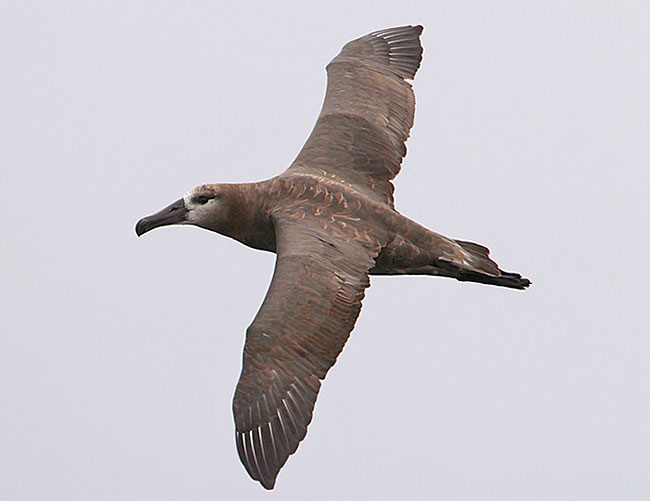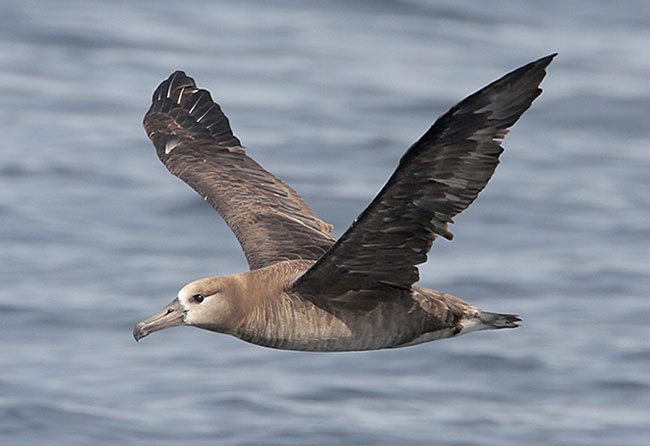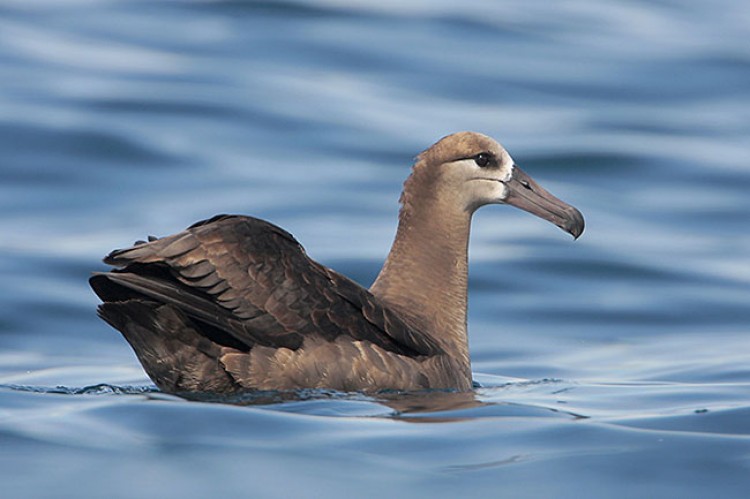A master of long-distance ocean travel, the Black-footed Albatross soars on winds and air currents above the ocean’s surface and ranges widely from its island breeding areas. Black-footed Albatross can be seen regularly off the Pacific Coast of North America on whale-watching and pelagic birding trips.
Drift nets and longlines used for commercial fishing have been major sources of mortality for the Black-footed Albatross, but conservation efforts are reducing the numbers affected. Black-footed Albatross do not breed until age 5-8, but have been known to live 40 years in the wild.
Length: 32 in.
Wingspan: 80 in.
On this page
Description of the Black-footed Albatross
BREEDING MALE

Photograph © Greg Lavaty
The Black-footed Albatross is nearly all dark in plumage except for white tail coverts, and has an extraordinarily large wingspan and narrow wings.
Female
Sexes similar.
Seasonal change in appearance
None.
Juvenile
Similar to adults but with dark tail coverts.
Habitat
Open ocean.
Diet
Fish, crustaceans, and squid.

Photograph © Greg Lavaty
Behavior
Forages while swimming or makes shallow dives.
Range
Pacific Ocean from Alaska to Mexico, occurring in northern portions of this area in summer, and farther south in winter.
Fun Facts
The Black-footed Albatross has an excellent sense of smell, which helps it locate feeding areas.
The Black-footed Albatross spends more time on the water during the day than at night.
Vocalizations
The most common call is an “eh-eh”.
Similar Species
Other regular albatross in North America have much more white in their plumage.
Nesting
The nest is depression in beach sand.
Number: 1.
Color: Whitish with darker markings.
Incubation and fledging:
– Young hatch at 65-66 days.
– Young fledge (leave the nest) 140 days after hatching days.
Bent Life History of the Black-footed Albatross
Published by the Smithsonian Institution between the 1920s and the 1950s, the Bent life history series of monographs provide an often colorful description of the birds of North America. Arthur Cleveland Bent was the lead author for the series. The Bent series is a great resource and often includes quotes from early American Ornithologists, including Audubon, Townsend, Wilson, Sutton and many others.
Bent Life History for the Black-footed Albatross – the common name and sub-species reflect the nomenclature in use at the time the description was written.
PHOEBASTRIA NIGRIPES (Audubon)
As we steamed out through Dixon Entrance we soon realized that we were actually going to sea, as the good ship Takorna rose and fell on. the long ocean swell. The numerous gulls which had been following the ship became fewer and fewer, as the land faded from view, and they were gradually replaced by the pretty little fork-tailed petrels, so common on the north Pacific, and the graceful fulmars which were circling about us. An occasional tufted puffin was seen, a pelagic species during most of the year, hut most of the gulls and other migrating waterfowl had been left behind before we began to see the long saber-like wings of the black-footed albatrosses or “goonies,” as they are called, skimming low over the heaving billows of the ocean, pelagic wanderers from warmer climes, gleaning a scanty living from the watery wastes. During our four days’ trip over the Pacific Ocean to Unimak Pass they were our constant companions. In stormy weather, of which we had plenty~ they were more numerous and active, sometimes as many as six being seen about the ship at one time. They will always be associated in my memory with the ocean storms, with the plunging of the ship over mountainous seas and with the whirr of racing pro pellers over the crests of mighty waves. Amid all the grandeur, excitement, and danger of a storm at sea the albatross glides calmly on, rising easily over the crests of the highest waves and gracefully sailing down into the valleys between them, frequently lost to sight but never troubled or confused, thoroughly at home in its native element. What mariner would not respect the bird that shows such mastery of the sea in all its wildest moods? Although the black-footed albatross is a bird of the northern hemisphere, living its life on the Pacific Ocean north of the equator~ it shares with the antarctic Tubinares the habit of breeding during our winter months, resorting to the islands in the Hawaiian group for this purpose early in November. Dr. T. W. iRichards (1909) says of its arrival on the Midway Islands, situated in latitude 280 13″ North and longitude 1770 21′ West:
In 1906 nigripea arrived the first week in November, immutahilig following a few days later, and by the 20th of the month both species had deposited eggs. Dr. Campbell believes that the birds pair after arrival, but it would seem that some, at least, may have mated previously.
Courtship: The courtship dance of the Laysan albatross has been fully described by Dr. Walter K. Fisher (1904), and the same curious performance is indulged in by the black-footed species with some variations. Doctor Fisher noted the following differences in the ceremony:
I saw the black-footed albatrosses (D. nigripes) rather seldom engaged in the dance, and indeed they impress one as more matter-of-fact creatures. The only difference which was observed in the ceremony as carried out by the two species is that nigripee spreads its wings slightly (the metacarpus or ‘ hand” being folded closed) when It lifts Its head to utter the nasal song.
Prof. Homer R. Dill (1912) says that it is similar, but much more elaborate, and they go through the figures slowly and gracefully. Instead of lifting one wing they raise both. They are ve~-y neighborly with the other species. We often saw them visiting, and on one to two occasions they were trying to perform with them, but the rapid pace set by the white bird was rather too much for his more deliberate cousin, and the affair ended disastrously.
According to Doctor Fisher (1904a), Dr. Charles H. Gilbert, while cruising about a hundred miles off San Diego, California, on the steamer Albatross, saw six black-footed albatrosses pair off and indulge in this peculiar dance. This was during the latter part of March, when the adult birds should have been on their breeding grounds, but these were apparently immature birds.
Nesting: Doctor Fisher (1906) says of the breeding habits of this species on Laysan Island:
The black-footed albatross is very much less abundant on Laysan than the white species. It colonizes the sandy beaches on the north, east, and south sides, but is not found, except rarely, on the west side. It is likewise common on the sedge-covered slope near the beach, in the same habitat with Sula cyanops. On one or two occasions I noted them in the interior with D. i,mrnuta.bills.
The nest is a mere hollow scratched in the bare sand, without even a rim of sand raised around it.
Eggs: Doctor Richards (1909) describes the eggs as follows:
Each pair of birds: -and this applies to both species: rarely lays more than one egg in a season, if undisturbed; and if a second egg should be deposited the first is thrown out, leaving but one to incubate. If, as was formerly the case, the nests are systematically robbed, four eggs are usually supplied by each. In nearly all published descriptions of eggs of the Diornedeidae they are referred to in terms somewhat as follows: White, sometimes speckled or sprinkled on larger end with reddish brown” (Ridgway), giving the Impression that they resemble, on a large scale4 eggs of the stormy petrel, for example. While this may be true of some species, it would be Inappropriate for a great many specimens of D. itigripcs, though seine are faintly speckled or even Immaculate. In many instances, however, these eggs are boldly and handsomely splashed with dark brownish red, in some forming a cap or wreath about one end, usually the larger; in others, extending over nearly one-half the shell; In fact there Is as much color, relatively, as on an average egg of any of our larger Buteos, though it is apt to be more constantly confined to one end. Compared with eggs of immatabitis they average more color, but extremes easily overlap and Identity can not be determined from the eggs alone.
The measurements of 45 eggs, in various collections, average 108.8 by 70.8 millimeters; the eggs showing the four extremes measure 120.7 by 69.8, 109.5 by 86, 98.1 by 68.4, and 109.3 by 56 millimeters.
Young: Doctor Richards (1909) says further:
Incubation lasts about six weeks, both birds taking turns on the nest so that the egg Is constantly covered. The young are fed, in the well-known manner, by regurgitation from the throat of the parent, remaining about the islands until the following .June or July, so that the entire reproductive period occupies about one-half the year.
The young are probably nearly six months old before they are able to fly.
Plumages: Immature birds, during the first year at least or perhaps longer, are in uniformly dark sooty plumage, a faint suggestion of the white face at the base of the bill and a few white feathers on the upper tail-coverts probably indicate approaching maturity. The dull white face and the pure white rump -and under tail-coverts are characteristic of the fully adult plumage which is certainly not acquired until the second year and probably not complete until much later.
Food: The food of this albatross consists of whatever edible refuse it can pick up from the surface of the sea. It follows vessels persistently for the purpose of picking up bits of garbage thrown overboard, over which it often quarrels with its neighbor. From a slow-moving sailing vessel it can easily be caught with a hook and line, baited with almost any kind of animal food; but we were unable to hook any from our fast-moving revenue cutter, although the birds made repeated attempts to seize the bait. It is said by Baird, Brewer, and Ridgway (1884) to feed largely on “a pelagic crab.”
Behavior: Doctor Fisher (1906) has desqribed the flight of this species so well that I can not do better than quote his remarks as follows:
As is well known, albatrosses are past masters at soaring or sailing. If the wind is favorable they are able to skim over the water for a long tIme without once flapping their wings. D. nigripes Is certainly no exception to the general rule, and we had ample opportunity to witness their powers. The long slender wings, with long humerni bones, are eminently fitted for this sort of existence, and their construction renders flapping laborious, for in proportion to Its size the albatross is not a very muscular creature and could not fly a great distance if obliged to do so by wing beats. When a stiff breeze Is blowing albatrosses can sail only against the wind or with it, and are able to quarter a breeze, or go directly across it only for a short distance and when under great momentum. When we were steaming directly against the wind the albatrosses had no trouble in following us, and they would fly all around the ship without flapping their wings except when the breeze was strong, and then they were obliged to give a few vigorous beats when turning up Into the wind. When, however, our course lay at an angle to the wind, they followed us by sailing in a series of ellipses. They would, in this case, sail directly against the wind, approaching us on the starboard quarter, go over the stern a short distance to port, then wheel and scud before the breeze perhaps 100 yards off the starboard quarter, when they turned and approached us as before. Their speed was so superior to ours that they were able to keep up without any trouble, and their frequent trips astern and rapid overhauling again made our cumbersome gait all the mere apparent. Of course as they neared the turning point each time they had to quarter the breeze a little and for a moment sail directly across It.
The position in which the wings are held when sailing against or with the wind is quite characteristic In either case. When coming against the breeze the carpal segment and primaries are bent downward, as if to catch the wind, but when the bird turns and goes with the breeze the ends of the wings are bent up. When sailing against the wind they often gradually rise, but they are likewise perfectly capable of descending, and when going swiftly wIth the wind they not infrequently, In fact usually, make a long swoop downwnrd and skim over the water, rising a little as they turn to come to windward. The position of the wings In the two eases seems to be constant. In the first case they catch more wnd, and the fact that the birds generally rise a little shows that the wings act on the same principle as a kite. On the other band, when sailing with the breeze, the position is such as gives less resistance to the wind.
It was a constant source of delight to watch the graceful evolutions of this albatross, as it followed our ship day after day, rising and falling at will and sailing straight with the wind on rigid wings. The large webbed feet were stretched out beyond the tail, and, with webs extended, served as a rudder in turning. When alighting on the water the feet were spread wide apart, the tail was spread and depressed and the wings were held upwards as it dropped gently down onto the crest of a wave; it deliberately folded its long wings without wetting them, After alighting, it often drifted far astern before rising again. This it could easily do in rough weather by slowly unfolding its wings and launching into the air of! the crest of a wave, but in calm weather it was necessary for it to run along the surface to gain a little headway. If the wind was blowing strongly it could easily catch up with the ship without flapping its wings. It sits very high on the water and swims slowly.
Professor Dill (1912) says that the notes uttered during the nuptial dance are softer than those of the Laysan albatross and end “with a sound like the stroke of a bell under water or deep within the bird’s stomach.” They often give a whirring groan while quarreling over their food, and a similar note is sometimes heard on the wing, though they are usually silent.
The black-footed albatross is usually sociable and gentle with its neighbors on its breeding grounds, where it is more or less intimately associated with other albatrosses, boobies, shearwaters, and terns. It is on particularly intimate terms with the Laysan albatross indulging in the dance with it, but it has a bad habit of abusing its neighbors’ young, and Doctor Fisher (1906) says that “the process sometimes finishes the victim, for young which appear to have been misused are frequently seen lying around dead.”
Winter: After the prolonged duties of reproduction are over the birds scatter about for a few months of vacation. Breeding birds may be found on Laysan Island from November to August, but undoubtedly some individuals are earlier breeders than others, and I doubt if the breeding season for each pair of birds is extended over any such long period as ten months; probably it is not much over six months. Certainly, adult.s are seen at sea, hundreds of miles from their breeding grounds, during at least six months of the year, from May to October.
DISTRIBUTION
Breeding range: Central and western Pacific Ocean, north of the Equator (Laysan, Gaspar Rico, Midway, Marshall, Volcano, and Bonin Islands). Formerly on Marcus Island. Breeding grounds protected in Hawaiian Islands reservation.
Range: North Pacific Ocean, mainly north of the Tropic of Cancer. East to the coast of North America, from the Alaska Peninsula southward to Lower California (San Quentin Bay). South nearly or quite to the Equator. West to Formosa Channel, Japan (Yezzo), and the Kurile Islands. North to the Aleutian Islands and southern Bering Sea (Bristol Bay, Alaska) in summer.
Egg dates: Bonin Islands: Eight records, September 28 to December 1. Midway Island: Ten records, November 18 to 21. Laysan Island: Six records, November 18 to December 29.


